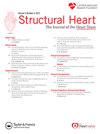功能性二尖瓣返流及经导管修复的作用
IF 2.8
Q3 CARDIAC & CARDIOVASCULAR SYSTEMS
引用次数: 0
摘要
继发性二尖瓣返流(SMR),被归类为室性或心房性二尖瓣返流,与高死亡率、心力衰竭住院和生活质量恶化相关。治疗首先针对潜在的心肌病,使用神经激素拮抗剂,心脏再同步化治疗和心律失常减少,这可以降低MR严重程度并改善预后,然后进行经导管治疗。在MR评估中,多模态成像对于确定机制、严重程度和干预方案至关重要。严重SMR的经导管治疗为尽管有最佳的医疗管理,但仍有症状的患者提供了经皮治疗的选择,并且在治疗的程序能力和设备方面已经取得了重大进展。MitraClip经皮治疗心力衰竭试验的心血管结局评估表明,使用二尖瓣经导管边缘到边缘修复(mTEER)可以改善发病率和死亡率。本试验的结果表明,比例MR越大,即MR的大小与左室高度扩张成比例,临床获益就越少。根据MitraClip经皮心衰治疗标准的心血管结局评估,在C期心衰患者中,mTEER可能改善心衰患者的症状和预后。这篇综述描述了我们目前对SMR的病理生理和治疗的理解。此外,它还探讨了一些问题,如经导管介入的最佳时机、mTEER在中度MR中的作用、我们对运动诱导MR的理解、对二尖瓣和心室重构的影响,以及mTEER是否可以促进药物治疗的优化。本文章由计算机程序翻译,如有差异,请以英文原文为准。
Functional Mitral Regurgitation and the Role of Transcatheter Repair
Secondary mitral regurgitation (SMR), classified as ventricular or atrial SMR, is associated with excess mortality, heart failure (HF) hospitalization, and worsening quality of life. Therapy is directed toward the underlying cardiomyopathy first with use of neurohormonal antagonism, cardiac resynchronization therapy and arrhythmia reduction, which can reduce MR severity and improve outcomes, followed by transcatheter therapies. Multimodality imaging in the evaluation of MR is critical to determine the mechanism, severity, and options for intervention. Transcatheter treatment of severe SMR provides a percutaneous option for patients who remain symptomatic despite optimal medical management, and there have been significant advances in the procedural capabilities and devices available for treatment. The Cardiovascular Outcomes Assessment of the MitraClip Percutaneous Therapy for Heart Failure trial demonstrated improvement in morbidity and mortality with use of mitral transcatheter edge-to-edge repair (mTEER). The results of this trial suggest that greater proportionate MR, in which the magnitude of MR is accompanied proportionately with a high degree of LV dilation, confers less clinical benefit. A window of opportunity exists during which time mTEER may improve symptoms and prognosis in HF patients as guided by Cardiovascular Outcomes Assessment of the MitraClip Percutaneous Therapy for Heart Failure criteria in stage C HF. This review describes our current understanding of the pathophysiology and treatment of SMR. Additionally, it explores several questions as to the optimal timing of transcatheter intervention, the role of mTEER in moderate MR, our understanding of exercise-induced MR, implications for mitral valvular and ventricular remodeling, and whether mTEER may facilitate optimization of medical therapy.
求助全文
通过发布文献求助,成功后即可免费获取论文全文。
去求助
来源期刊

Structural Heart
Medicine-Cardiology and Cardiovascular Medicine
CiteScore
1.60
自引率
0.00%
发文量
81
 求助内容:
求助内容: 应助结果提醒方式:
应助结果提醒方式:


